Research on Employee Deviant Behavior and Performance in Management
VerifiedAdded on 2021/02/20
|84
|20023
|227
Report
AI Summary
This report presents an in-depth analysis of employee deviant behavior and its influence on organizational performance, mediated by organizational commitment. The research investigates the impact of employee actions, both positive and negative, within various organizational contexts. It examines the correlation between employee behavior at work and their mindset to develop effective strategic formations and controls. The report covers the research background, rationale, literature review of key theories and recent empirical research, and research methodology, including research design, data collection methods, and ethical considerations. The data analysis section includes demographic information, normality tests, reliability assessments, descriptive statistics, correlation analyses, and regression analyses, culminating in hypothesis testing. The discussion section provides an interpretation of the findings, followed by conclusions and recommendations. The study also reflects on alternative research methodologies and provides a comprehensive list of references, offering valuable insights into employee behavior and its effects on organizational success.
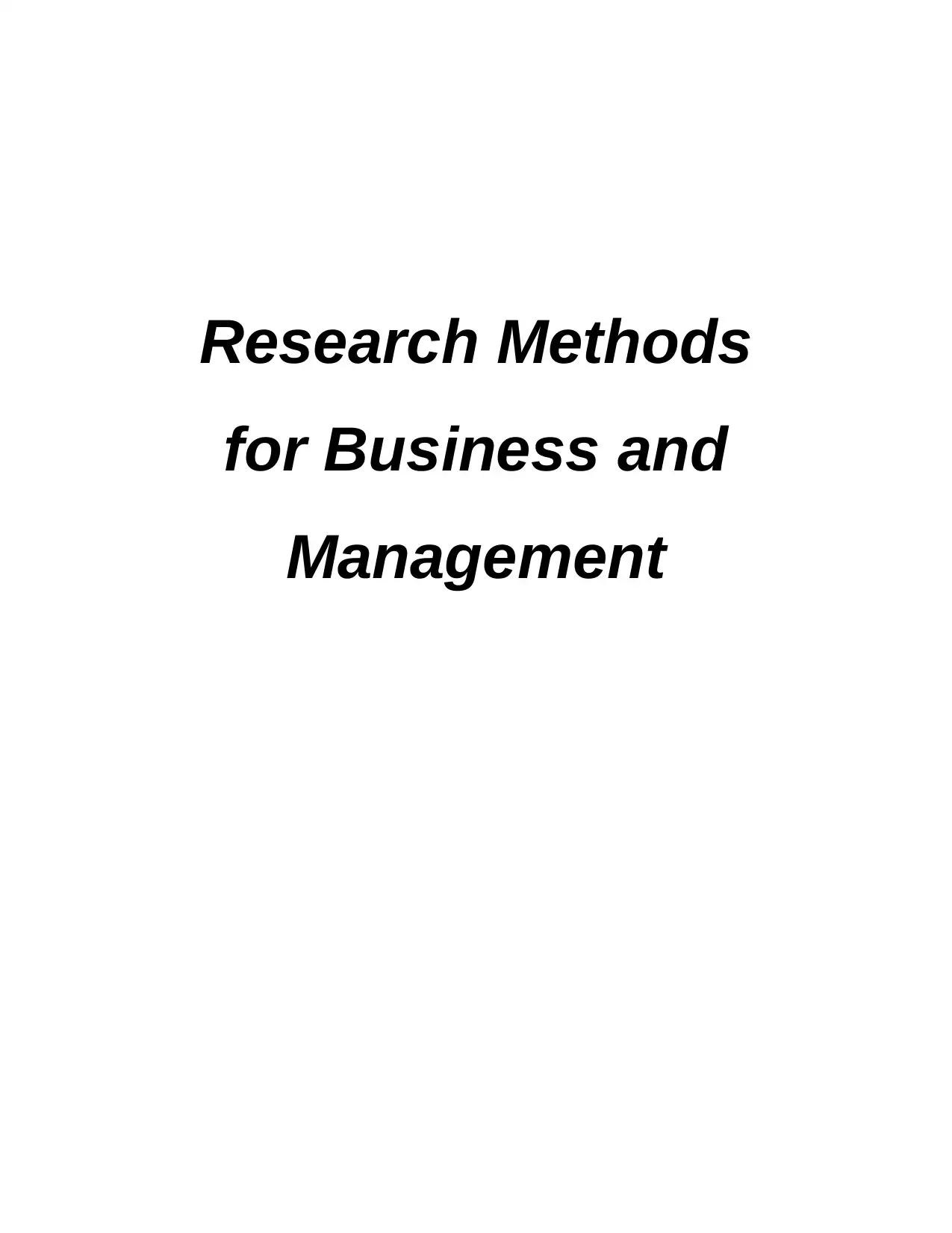
Research Methods
for Business and
Management
for Business and
Management
Paraphrase This Document
Need a fresh take? Get an instant paraphrase of this document with our AI Paraphraser
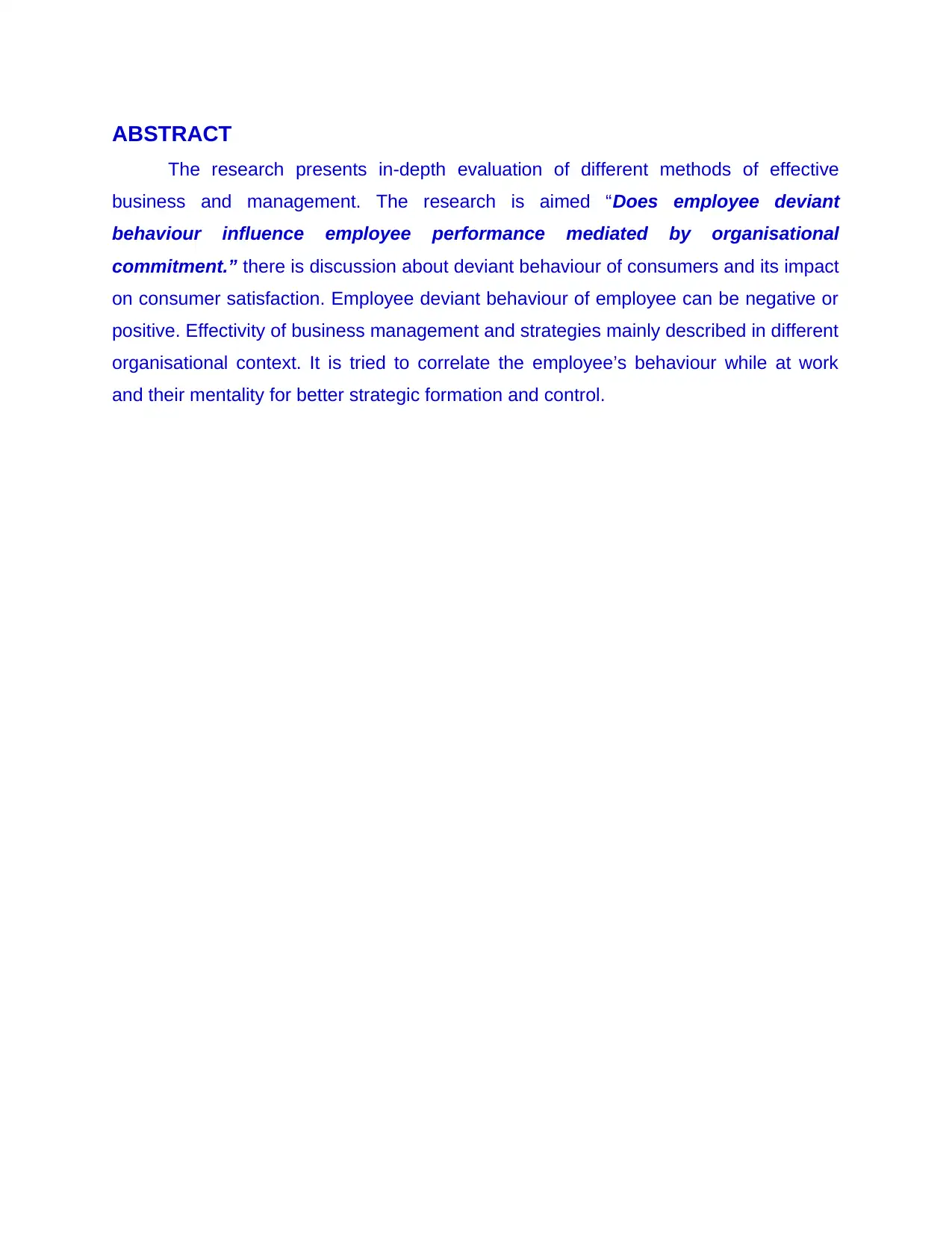
ABSTRACT
The research presents in-depth evaluation of different methods of effective
business and management. The research is aimed “Does employee deviant
behaviour influence employee performance mediated by organisational
commitment.” there is discussion about deviant behaviour of consumers and its impact
on consumer satisfaction. Employee deviant behaviour of employee can be negative or
positive. Effectivity of business management and strategies mainly described in different
organisational context. It is tried to correlate the employee’s behaviour while at work
and their mentality for better strategic formation and control.
The research presents in-depth evaluation of different methods of effective
business and management. The research is aimed “Does employee deviant
behaviour influence employee performance mediated by organisational
commitment.” there is discussion about deviant behaviour of consumers and its impact
on consumer satisfaction. Employee deviant behaviour of employee can be negative or
positive. Effectivity of business management and strategies mainly described in different
organisational context. It is tried to correlate the employee’s behaviour while at work
and their mentality for better strategic formation and control.
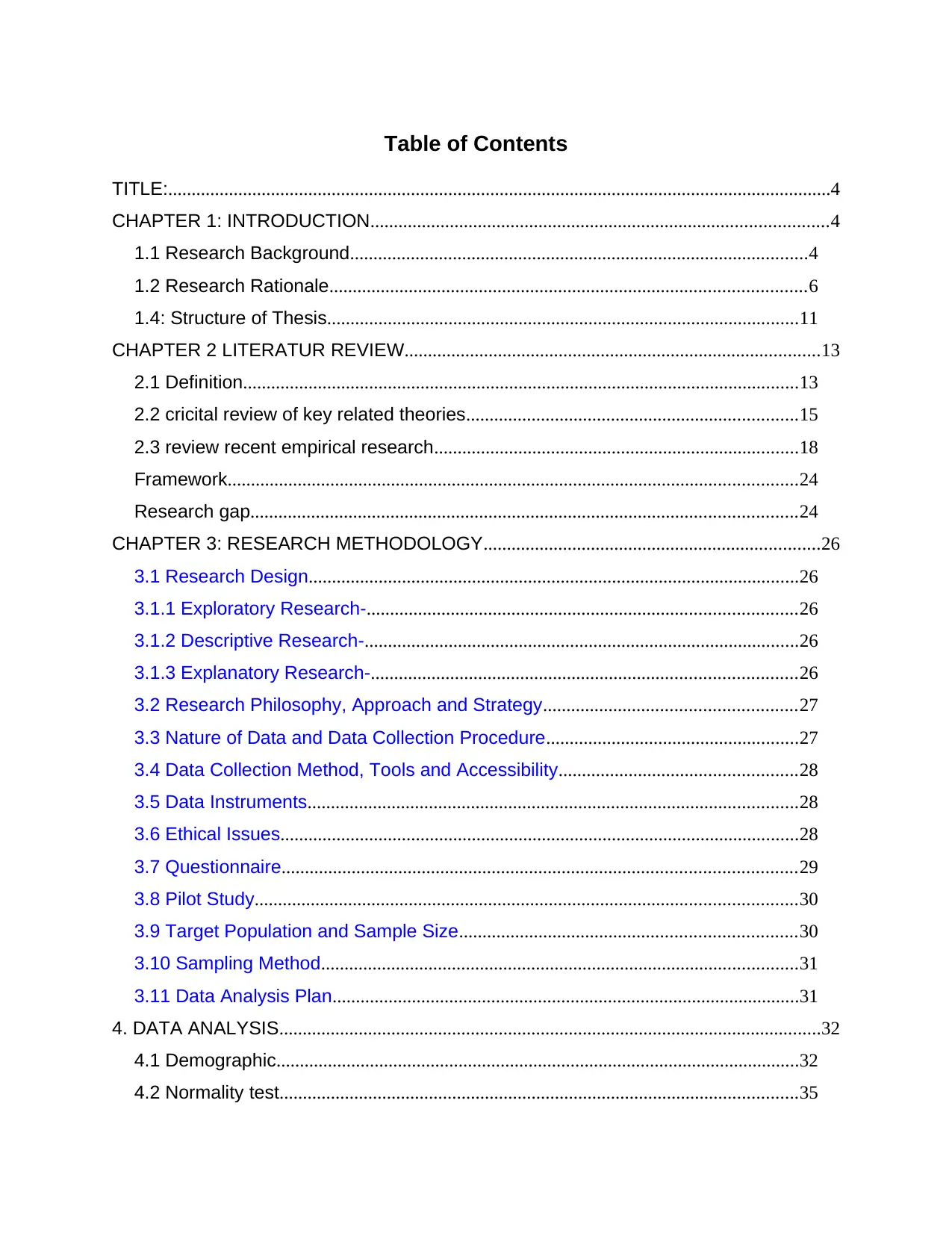
Table of Contents
TITLE:..............................................................................................................................................4
CHAPTER 1: INTRODUCTION..................................................................................................4
1.1 Research Background..................................................................................................4
1.2 Research Rationale......................................................................................................6
1.4: Structure of Thesis.....................................................................................................11
CHAPTER 2 LITERATUR REVIEW.........................................................................................13
2.1 Definition.......................................................................................................................13
2.2 cricital review of key related theories.......................................................................15
2.3 review recent empirical research..............................................................................18
Framework..........................................................................................................................24
Research gap.....................................................................................................................24
CHAPTER 3: RESEARCH METHODOLOGY........................................................................26
3.1 Research Design.........................................................................................................26
3.1.1 Exploratory Research-............................................................................................26
3.1.2 Descriptive Research-.............................................................................................26
3.1.3 Explanatory Research-...........................................................................................26
3.2 Research Philosophy, Approach and Strategy......................................................27
3.3 Nature of Data and Data Collection Procedure......................................................27
3.4 Data Collection Method, Tools and Accessibility...................................................28
3.5 Data Instruments.........................................................................................................28
3.6 Ethical Issues...............................................................................................................28
3.7 Questionnaire..............................................................................................................29
3.8 Pilot Study....................................................................................................................30
3.9 Target Population and Sample Size........................................................................30
3.10 Sampling Method......................................................................................................31
3.11 Data Analysis Plan....................................................................................................31
4. DATA ANALYSIS....................................................................................................................32
4.1 Demographic................................................................................................................32
4.2 Normality test...............................................................................................................35
TITLE:..............................................................................................................................................4
CHAPTER 1: INTRODUCTION..................................................................................................4
1.1 Research Background..................................................................................................4
1.2 Research Rationale......................................................................................................6
1.4: Structure of Thesis.....................................................................................................11
CHAPTER 2 LITERATUR REVIEW.........................................................................................13
2.1 Definition.......................................................................................................................13
2.2 cricital review of key related theories.......................................................................15
2.3 review recent empirical research..............................................................................18
Framework..........................................................................................................................24
Research gap.....................................................................................................................24
CHAPTER 3: RESEARCH METHODOLOGY........................................................................26
3.1 Research Design.........................................................................................................26
3.1.1 Exploratory Research-............................................................................................26
3.1.2 Descriptive Research-.............................................................................................26
3.1.3 Explanatory Research-...........................................................................................26
3.2 Research Philosophy, Approach and Strategy......................................................27
3.3 Nature of Data and Data Collection Procedure......................................................27
3.4 Data Collection Method, Tools and Accessibility...................................................28
3.5 Data Instruments.........................................................................................................28
3.6 Ethical Issues...............................................................................................................28
3.7 Questionnaire..............................................................................................................29
3.8 Pilot Study....................................................................................................................30
3.9 Target Population and Sample Size........................................................................30
3.10 Sampling Method......................................................................................................31
3.11 Data Analysis Plan....................................................................................................31
4. DATA ANALYSIS....................................................................................................................32
4.1 Demographic................................................................................................................32
4.2 Normality test...............................................................................................................35
⊘ This is a preview!⊘
Do you want full access?
Subscribe today to unlock all pages.

Trusted by 1+ million students worldwide
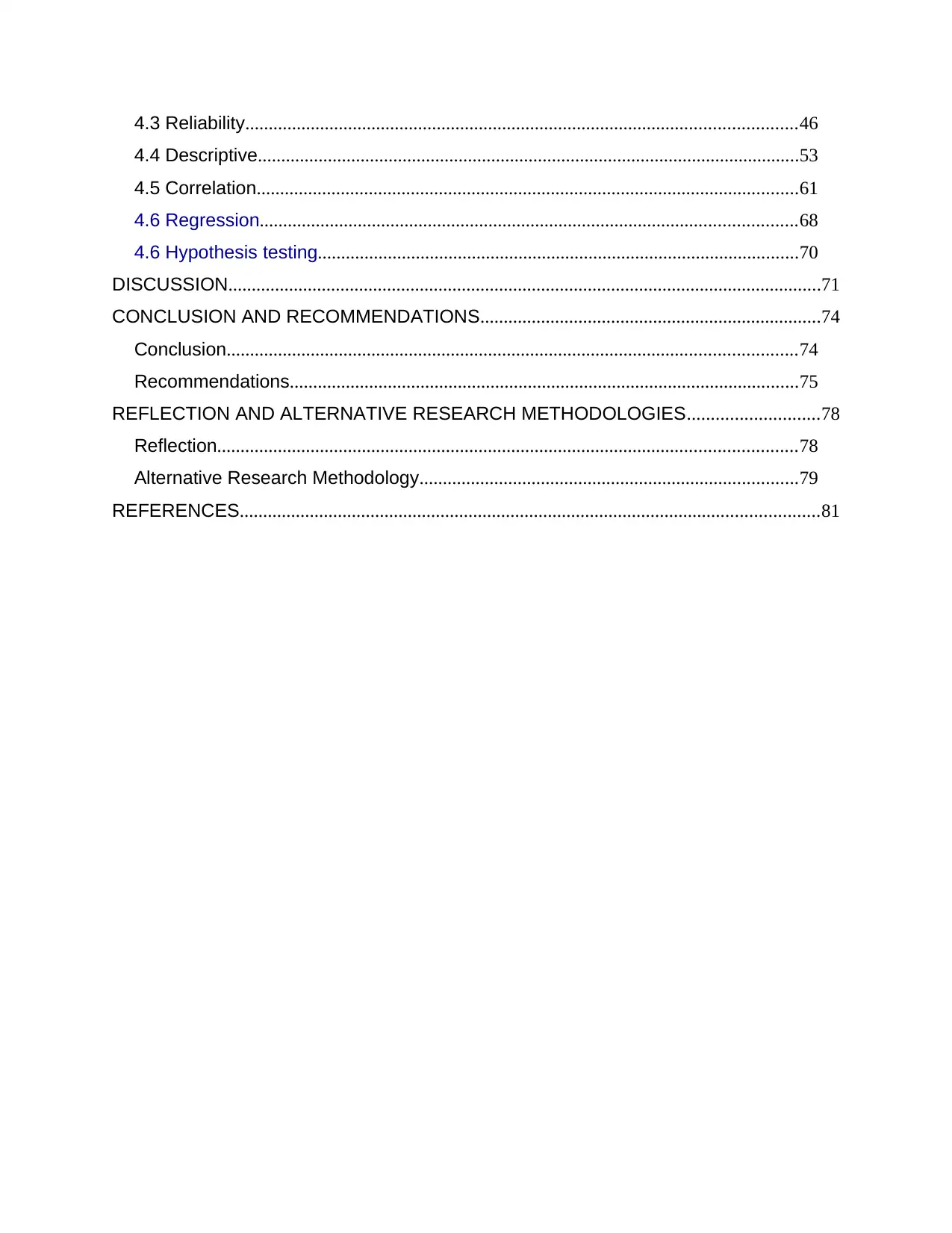
4.3 Reliability......................................................................................................................46
4.4 Descriptive....................................................................................................................53
4.5 Correlation....................................................................................................................61
4.6 Regression...................................................................................................................68
4.6 Hypothesis testing.......................................................................................................70
DISCUSSION...............................................................................................................................71
CONCLUSION AND RECOMMENDATIONS.........................................................................74
Conclusion..........................................................................................................................74
Recommendations.............................................................................................................75
REFLECTION AND ALTERNATIVE RESEARCH METHODOLOGIES............................78
Reflection............................................................................................................................78
Alternative Research Methodology.................................................................................79
REFERENCES............................................................................................................................81
4.4 Descriptive....................................................................................................................53
4.5 Correlation....................................................................................................................61
4.6 Regression...................................................................................................................68
4.6 Hypothesis testing.......................................................................................................70
DISCUSSION...............................................................................................................................71
CONCLUSION AND RECOMMENDATIONS.........................................................................74
Conclusion..........................................................................................................................74
Recommendations.............................................................................................................75
REFLECTION AND ALTERNATIVE RESEARCH METHODOLOGIES............................78
Reflection............................................................................................................................78
Alternative Research Methodology.................................................................................79
REFERENCES............................................................................................................................81
Paraphrase This Document
Need a fresh take? Get an instant paraphrase of this document with our AI Paraphraser
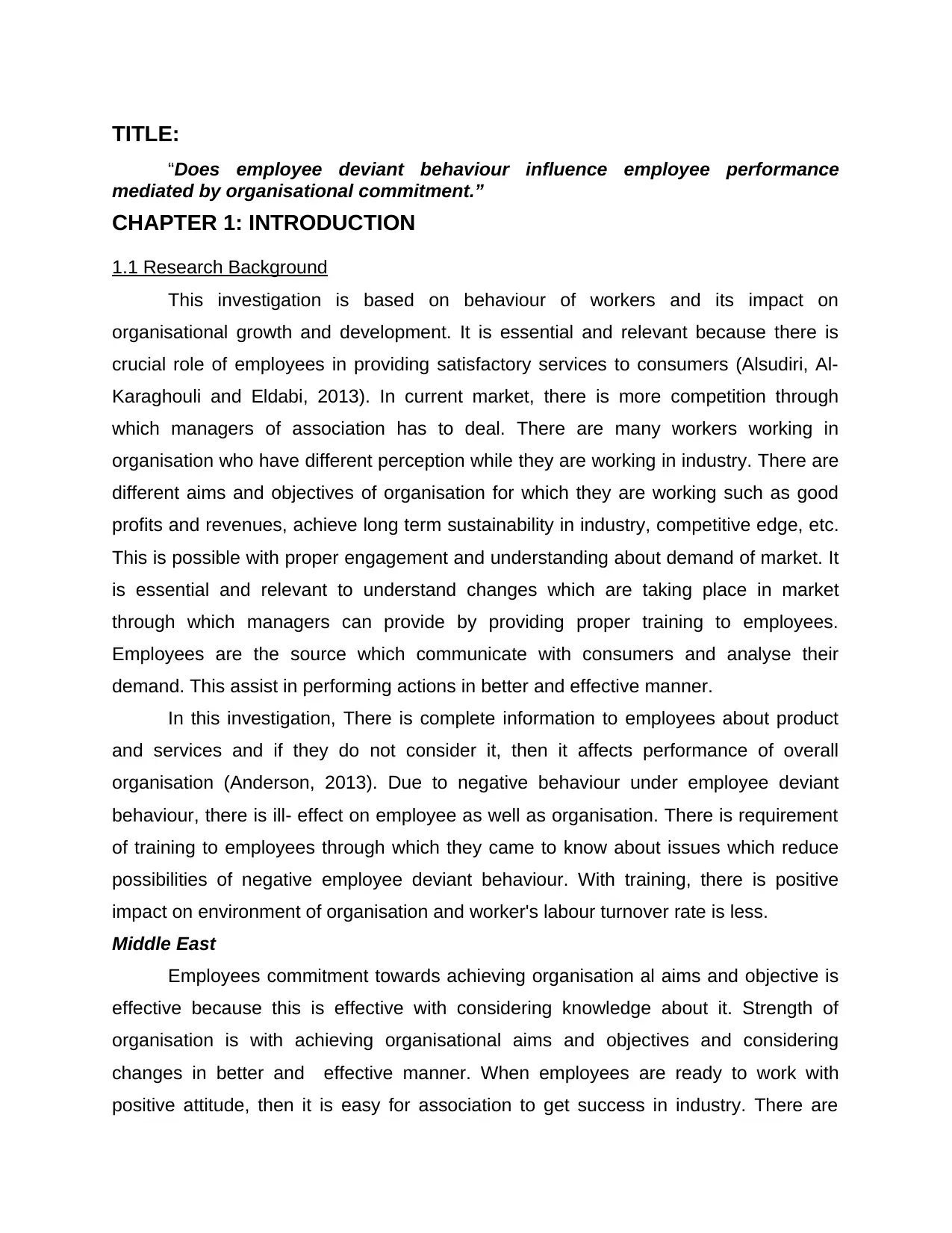
TITLE:
“Does employee deviant behaviour influence employee performance
mediated by organisational commitment.”
CHAPTER 1: INTRODUCTION
1.1 Research Background
This investigation is based on behaviour of workers and its impact on
organisational growth and development. It is essential and relevant because there is
crucial role of employees in providing satisfactory services to consumers (Alsudiri, Al-
Karaghouli and Eldabi, 2013). In current market, there is more competition through
which managers of association has to deal. There are many workers working in
organisation who have different perception while they are working in industry. There are
different aims and objectives of organisation for which they are working such as good
profits and revenues, achieve long term sustainability in industry, competitive edge, etc.
This is possible with proper engagement and understanding about demand of market. It
is essential and relevant to understand changes which are taking place in market
through which managers can provide by providing proper training to employees.
Employees are the source which communicate with consumers and analyse their
demand. This assist in performing actions in better and effective manner.
In this investigation, There is complete information to employees about product
and services and if they do not consider it, then it affects performance of overall
organisation (Anderson, 2013). Due to negative behaviour under employee deviant
behaviour, there is ill- effect on employee as well as organisation. There is requirement
of training to employees through which they came to know about issues which reduce
possibilities of negative employee deviant behaviour. With training, there is positive
impact on environment of organisation and worker's labour turnover rate is less.
Middle East
Employees commitment towards achieving organisation al aims and objective is
effective because this is effective with considering knowledge about it. Strength of
organisation is with achieving organisational aims and objectives and considering
changes in better and effective manner. When employees are ready to work with
positive attitude, then it is easy for association to get success in industry. There are
“Does employee deviant behaviour influence employee performance
mediated by organisational commitment.”
CHAPTER 1: INTRODUCTION
1.1 Research Background
This investigation is based on behaviour of workers and its impact on
organisational growth and development. It is essential and relevant because there is
crucial role of employees in providing satisfactory services to consumers (Alsudiri, Al-
Karaghouli and Eldabi, 2013). In current market, there is more competition through
which managers of association has to deal. There are many workers working in
organisation who have different perception while they are working in industry. There are
different aims and objectives of organisation for which they are working such as good
profits and revenues, achieve long term sustainability in industry, competitive edge, etc.
This is possible with proper engagement and understanding about demand of market. It
is essential and relevant to understand changes which are taking place in market
through which managers can provide by providing proper training to employees.
Employees are the source which communicate with consumers and analyse their
demand. This assist in performing actions in better and effective manner.
In this investigation, There is complete information to employees about product
and services and if they do not consider it, then it affects performance of overall
organisation (Anderson, 2013). Due to negative behaviour under employee deviant
behaviour, there is ill- effect on employee as well as organisation. There is requirement
of training to employees through which they came to know about issues which reduce
possibilities of negative employee deviant behaviour. With training, there is positive
impact on environment of organisation and worker's labour turnover rate is less.
Middle East
Employees commitment towards achieving organisation al aims and objective is
effective because this is effective with considering knowledge about it. Strength of
organisation is with achieving organisational aims and objectives and considering
changes in better and effective manner. When employees are ready to work with
positive attitude, then it is easy for association to get success in industry. There are
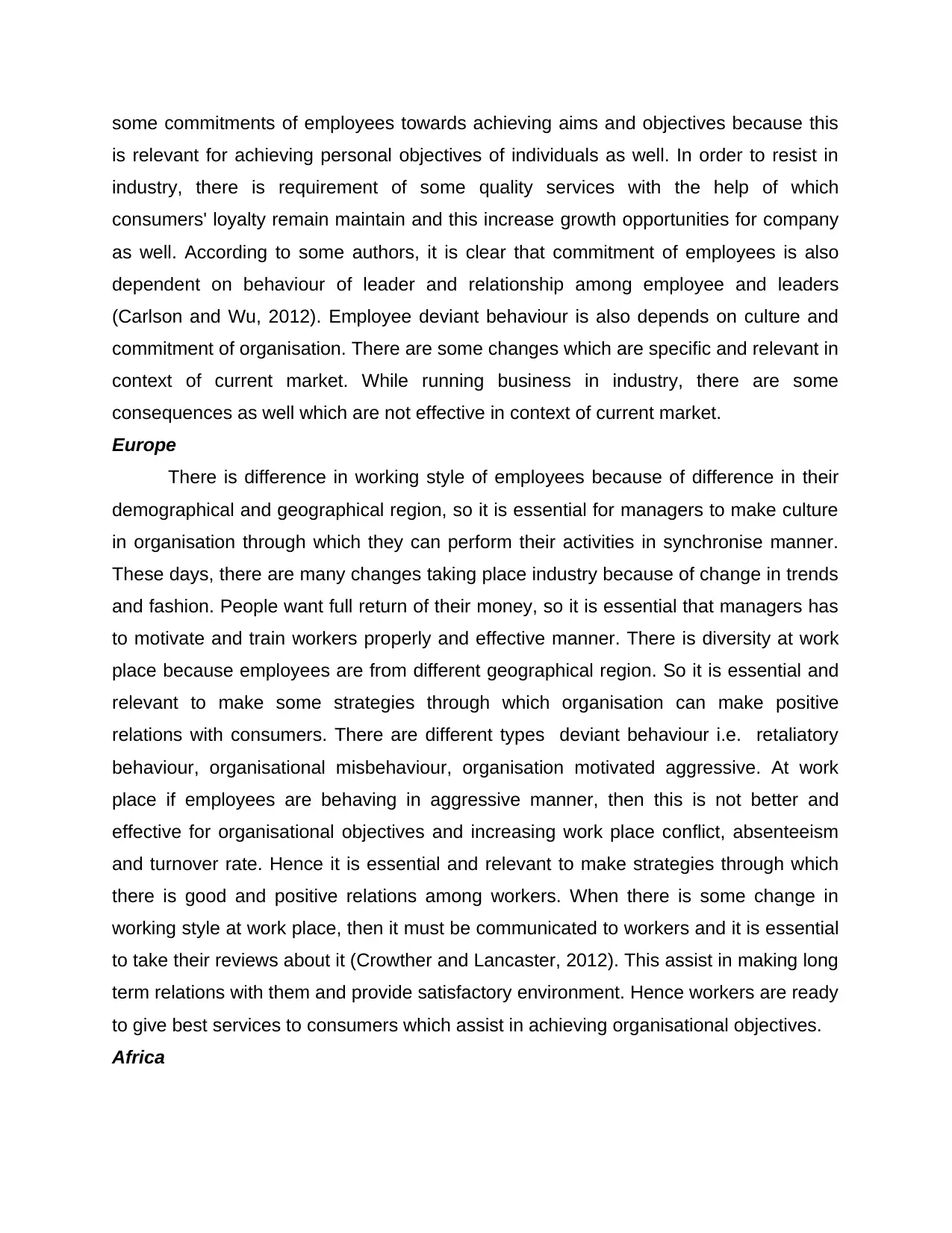
some commitments of employees towards achieving aims and objectives because this
is relevant for achieving personal objectives of individuals as well. In order to resist in
industry, there is requirement of some quality services with the help of which
consumers' loyalty remain maintain and this increase growth opportunities for company
as well. According to some authors, it is clear that commitment of employees is also
dependent on behaviour of leader and relationship among employee and leaders
(Carlson and Wu, 2012). Employee deviant behaviour is also depends on culture and
commitment of organisation. There are some changes which are specific and relevant in
context of current market. While running business in industry, there are some
consequences as well which are not effective in context of current market.
Europe
There is difference in working style of employees because of difference in their
demographical and geographical region, so it is essential for managers to make culture
in organisation through which they can perform their activities in synchronise manner.
These days, there are many changes taking place industry because of change in trends
and fashion. People want full return of their money, so it is essential that managers has
to motivate and train workers properly and effective manner. There is diversity at work
place because employees are from different geographical region. So it is essential and
relevant to make some strategies through which organisation can make positive
relations with consumers. There are different types deviant behaviour i.e. retaliatory
behaviour, organisational misbehaviour, organisation motivated aggressive. At work
place if employees are behaving in aggressive manner, then this is not better and
effective for organisational objectives and increasing work place conflict, absenteeism
and turnover rate. Hence it is essential and relevant to make strategies through which
there is good and positive relations among workers. When there is some change in
working style at work place, then it must be communicated to workers and it is essential
to take their reviews about it (Crowther and Lancaster, 2012). This assist in making long
term relations with them and provide satisfactory environment. Hence workers are ready
to give best services to consumers which assist in achieving organisational objectives.
Africa
is relevant for achieving personal objectives of individuals as well. In order to resist in
industry, there is requirement of some quality services with the help of which
consumers' loyalty remain maintain and this increase growth opportunities for company
as well. According to some authors, it is clear that commitment of employees is also
dependent on behaviour of leader and relationship among employee and leaders
(Carlson and Wu, 2012). Employee deviant behaviour is also depends on culture and
commitment of organisation. There are some changes which are specific and relevant in
context of current market. While running business in industry, there are some
consequences as well which are not effective in context of current market.
Europe
There is difference in working style of employees because of difference in their
demographical and geographical region, so it is essential for managers to make culture
in organisation through which they can perform their activities in synchronise manner.
These days, there are many changes taking place industry because of change in trends
and fashion. People want full return of their money, so it is essential that managers has
to motivate and train workers properly and effective manner. There is diversity at work
place because employees are from different geographical region. So it is essential and
relevant to make some strategies through which organisation can make positive
relations with consumers. There are different types deviant behaviour i.e. retaliatory
behaviour, organisational misbehaviour, organisation motivated aggressive. At work
place if employees are behaving in aggressive manner, then this is not better and
effective for organisational objectives and increasing work place conflict, absenteeism
and turnover rate. Hence it is essential and relevant to make strategies through which
there is good and positive relations among workers. When there is some change in
working style at work place, then it must be communicated to workers and it is essential
to take their reviews about it (Crowther and Lancaster, 2012). This assist in making long
term relations with them and provide satisfactory environment. Hence workers are ready
to give best services to consumers which assist in achieving organisational objectives.
Africa
⊘ This is a preview!⊘
Do you want full access?
Subscribe today to unlock all pages.

Trusted by 1+ million students worldwide
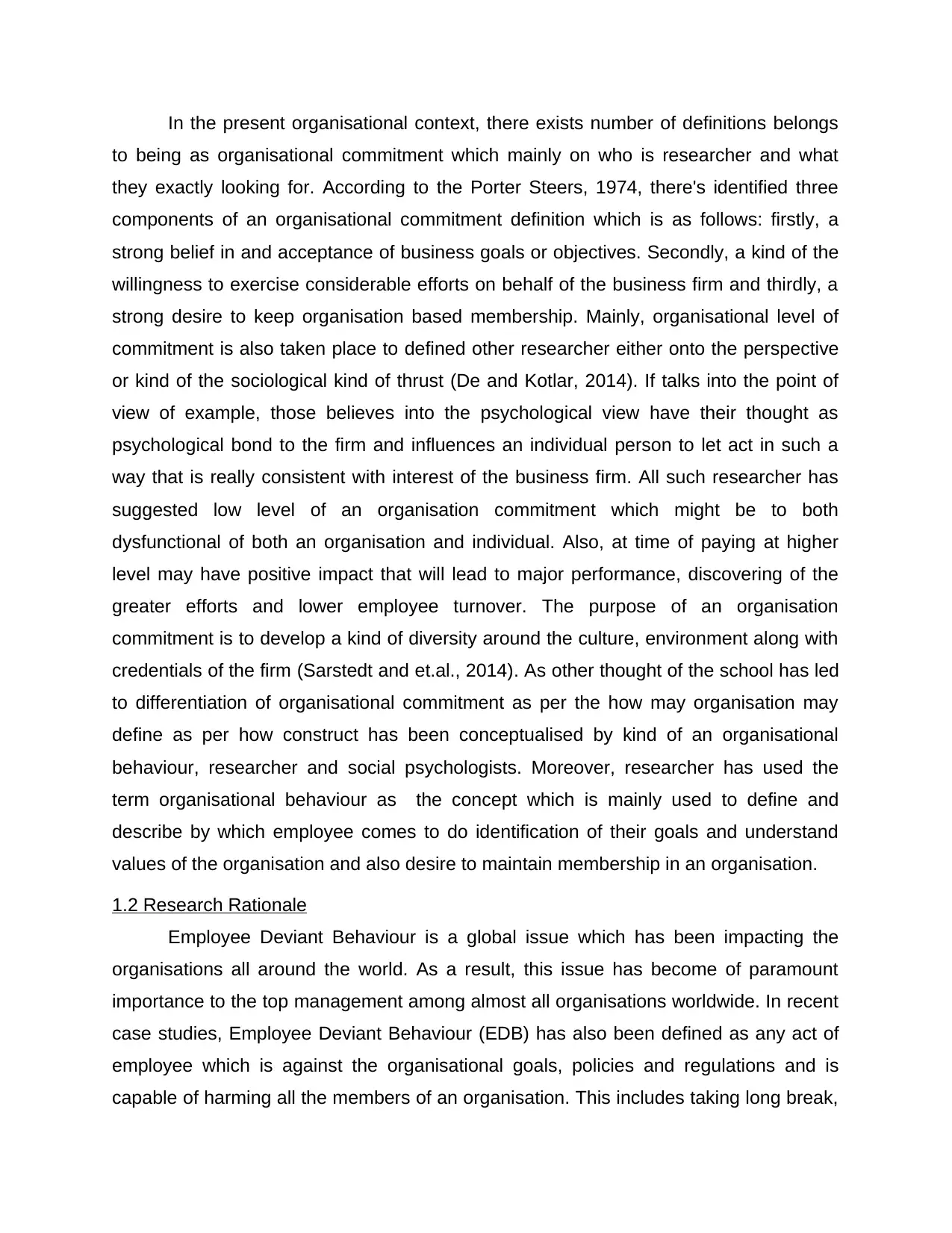
In the present organisational context, there exists number of definitions belongs
to being as organisational commitment which mainly on who is researcher and what
they exactly looking for. According to the Porter Steers, 1974, there's identified three
components of an organisational commitment definition which is as follows: firstly, a
strong belief in and acceptance of business goals or objectives. Secondly, a kind of the
willingness to exercise considerable efforts on behalf of the business firm and thirdly, a
strong desire to keep organisation based membership. Mainly, organisational level of
commitment is also taken place to defined other researcher either onto the perspective
or kind of the sociological kind of thrust (De and Kotlar, 2014). If talks into the point of
view of example, those believes into the psychological view have their thought as
psychological bond to the firm and influences an individual person to let act in such a
way that is really consistent with interest of the business firm. All such researcher has
suggested low level of an organisation commitment which might be to both
dysfunctional of both an organisation and individual. Also, at time of paying at higher
level may have positive impact that will lead to major performance, discovering of the
greater efforts and lower employee turnover. The purpose of an organisation
commitment is to develop a kind of diversity around the culture, environment along with
credentials of the firm (Sarstedt and et.al., 2014). As other thought of the school has led
to differentiation of organisational commitment as per the how may organisation may
define as per how construct has been conceptualised by kind of an organisational
behaviour, researcher and social psychologists. Moreover, researcher has used the
term organisational behaviour as the concept which is mainly used to define and
describe by which employee comes to do identification of their goals and understand
values of the organisation and also desire to maintain membership in an organisation.
1.2 Research Rationale
Employee Deviant Behaviour is a global issue which has been impacting the
organisations all around the world. As a result, this issue has become of paramount
importance to the top management among almost all organisations worldwide. In recent
case studies, Employee Deviant Behaviour (EDB) has also been defined as any act of
employee which is against the organisational goals, policies and regulations and is
capable of harming all the members of an organisation. This includes taking long break,
to being as organisational commitment which mainly on who is researcher and what
they exactly looking for. According to the Porter Steers, 1974, there's identified three
components of an organisational commitment definition which is as follows: firstly, a
strong belief in and acceptance of business goals or objectives. Secondly, a kind of the
willingness to exercise considerable efforts on behalf of the business firm and thirdly, a
strong desire to keep organisation based membership. Mainly, organisational level of
commitment is also taken place to defined other researcher either onto the perspective
or kind of the sociological kind of thrust (De and Kotlar, 2014). If talks into the point of
view of example, those believes into the psychological view have their thought as
psychological bond to the firm and influences an individual person to let act in such a
way that is really consistent with interest of the business firm. All such researcher has
suggested low level of an organisation commitment which might be to both
dysfunctional of both an organisation and individual. Also, at time of paying at higher
level may have positive impact that will lead to major performance, discovering of the
greater efforts and lower employee turnover. The purpose of an organisation
commitment is to develop a kind of diversity around the culture, environment along with
credentials of the firm (Sarstedt and et.al., 2014). As other thought of the school has led
to differentiation of organisational commitment as per the how may organisation may
define as per how construct has been conceptualised by kind of an organisational
behaviour, researcher and social psychologists. Moreover, researcher has used the
term organisational behaviour as the concept which is mainly used to define and
describe by which employee comes to do identification of their goals and understand
values of the organisation and also desire to maintain membership in an organisation.
1.2 Research Rationale
Employee Deviant Behaviour is a global issue which has been impacting the
organisations all around the world. As a result, this issue has become of paramount
importance to the top management among almost all organisations worldwide. In recent
case studies, Employee Deviant Behaviour (EDB) has also been defined as any act of
employee which is against the organisational goals, policies and regulations and is
capable of harming all the members of an organisation. This includes taking long break,
Paraphrase This Document
Need a fresh take? Get an instant paraphrase of this document with our AI Paraphraser
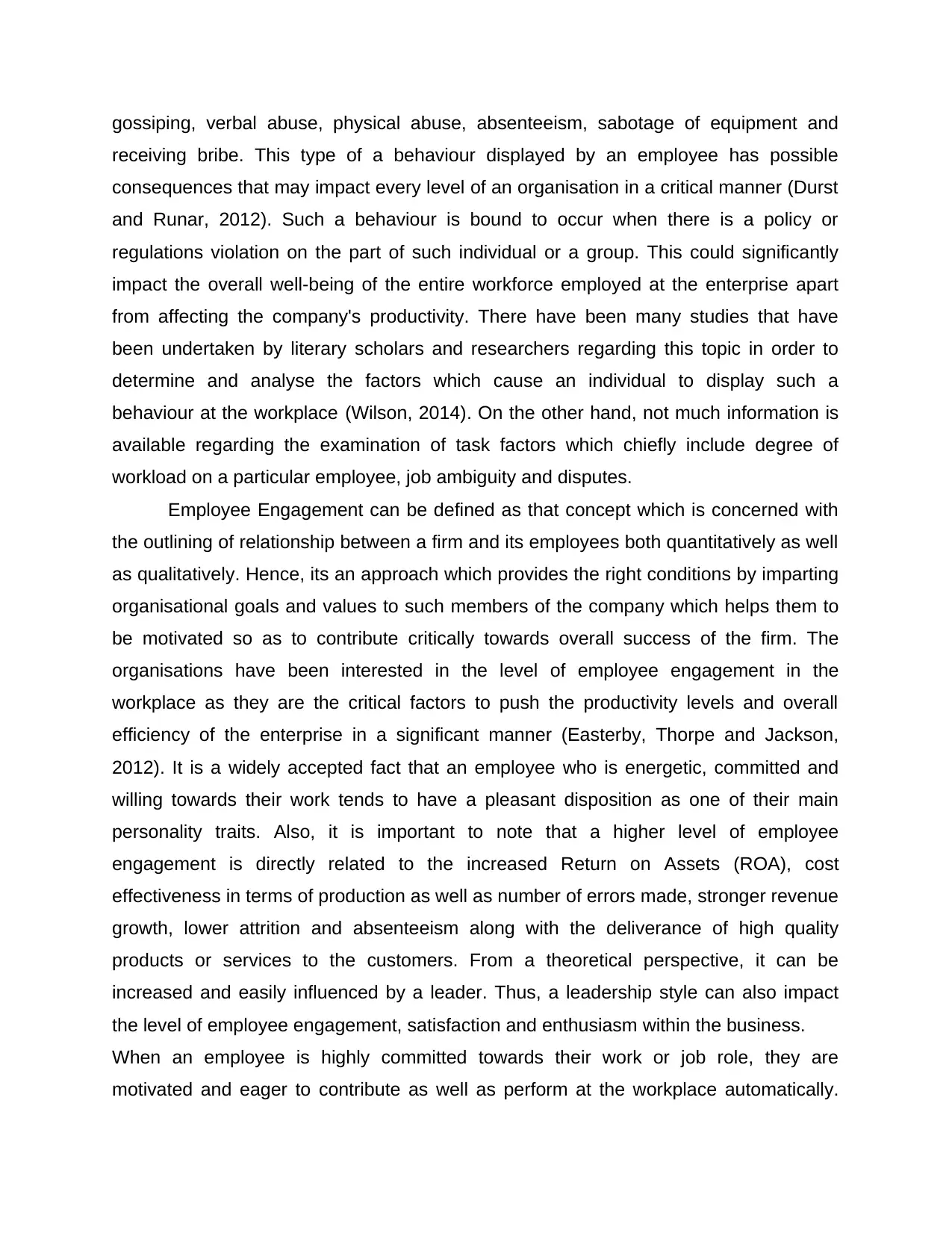
gossiping, verbal abuse, physical abuse, absenteeism, sabotage of equipment and
receiving bribe. This type of a behaviour displayed by an employee has possible
consequences that may impact every level of an organisation in a critical manner (Durst
and Runar, 2012). Such a behaviour is bound to occur when there is a policy or
regulations violation on the part of such individual or a group. This could significantly
impact the overall well-being of the entire workforce employed at the enterprise apart
from affecting the company's productivity. There have been many studies that have
been undertaken by literary scholars and researchers regarding this topic in order to
determine and analyse the factors which cause an individual to display such a
behaviour at the workplace (Wilson, 2014). On the other hand, not much information is
available regarding the examination of task factors which chiefly include degree of
workload on a particular employee, job ambiguity and disputes.
Employee Engagement can be defined as that concept which is concerned with
the outlining of relationship between a firm and its employees both quantitatively as well
as qualitatively. Hence, its an approach which provides the right conditions by imparting
organisational goals and values to such members of the company which helps them to
be motivated so as to contribute critically towards overall success of the firm. The
organisations have been interested in the level of employee engagement in the
workplace as they are the critical factors to push the productivity levels and overall
efficiency of the enterprise in a significant manner (Easterby, Thorpe and Jackson,
2012). It is a widely accepted fact that an employee who is energetic, committed and
willing towards their work tends to have a pleasant disposition as one of their main
personality traits. Also, it is important to note that a higher level of employee
engagement is directly related to the increased Return on Assets (ROA), cost
effectiveness in terms of production as well as number of errors made, stronger revenue
growth, lower attrition and absenteeism along with the deliverance of high quality
products or services to the customers. From a theoretical perspective, it can be
increased and easily influenced by a leader. Thus, a leadership style can also impact
the level of employee engagement, satisfaction and enthusiasm within the business.
When an employee is highly committed towards their work or job role, they are
motivated and eager to contribute as well as perform at the workplace automatically.
receiving bribe. This type of a behaviour displayed by an employee has possible
consequences that may impact every level of an organisation in a critical manner (Durst
and Runar, 2012). Such a behaviour is bound to occur when there is a policy or
regulations violation on the part of such individual or a group. This could significantly
impact the overall well-being of the entire workforce employed at the enterprise apart
from affecting the company's productivity. There have been many studies that have
been undertaken by literary scholars and researchers regarding this topic in order to
determine and analyse the factors which cause an individual to display such a
behaviour at the workplace (Wilson, 2014). On the other hand, not much information is
available regarding the examination of task factors which chiefly include degree of
workload on a particular employee, job ambiguity and disputes.
Employee Engagement can be defined as that concept which is concerned with
the outlining of relationship between a firm and its employees both quantitatively as well
as qualitatively. Hence, its an approach which provides the right conditions by imparting
organisational goals and values to such members of the company which helps them to
be motivated so as to contribute critically towards overall success of the firm. The
organisations have been interested in the level of employee engagement in the
workplace as they are the critical factors to push the productivity levels and overall
efficiency of the enterprise in a significant manner (Easterby, Thorpe and Jackson,
2012). It is a widely accepted fact that an employee who is energetic, committed and
willing towards their work tends to have a pleasant disposition as one of their main
personality traits. Also, it is important to note that a higher level of employee
engagement is directly related to the increased Return on Assets (ROA), cost
effectiveness in terms of production as well as number of errors made, stronger revenue
growth, lower attrition and absenteeism along with the deliverance of high quality
products or services to the customers. From a theoretical perspective, it can be
increased and easily influenced by a leader. Thus, a leadership style can also impact
the level of employee engagement, satisfaction and enthusiasm within the business.
When an employee is highly committed towards their work or job role, they are
motivated and eager to contribute as well as perform at the workplace automatically.
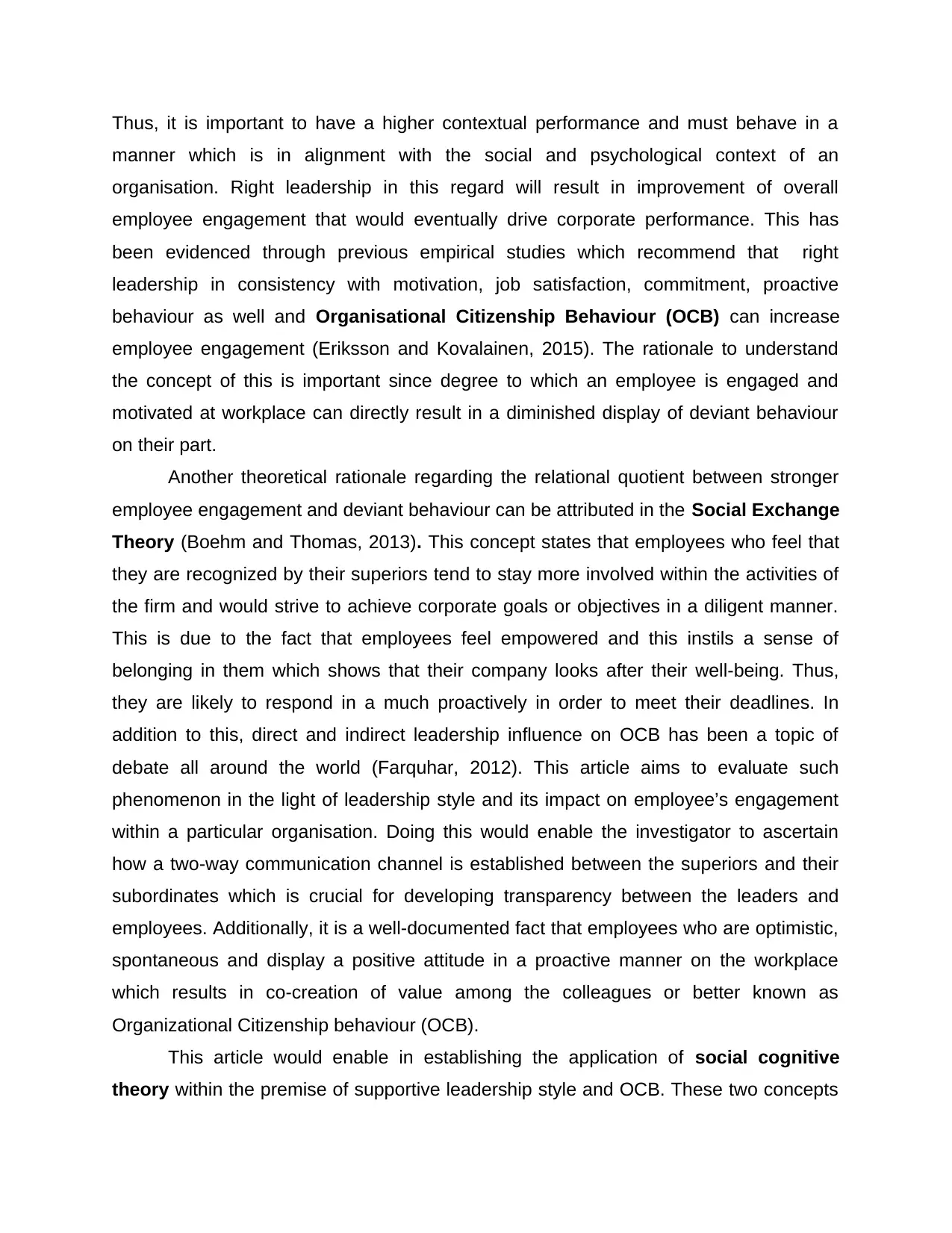
Thus, it is important to have a higher contextual performance and must behave in a
manner which is in alignment with the social and psychological context of an
organisation. Right leadership in this regard will result in improvement of overall
employee engagement that would eventually drive corporate performance. This has
been evidenced through previous empirical studies which recommend that right
leadership in consistency with motivation, job satisfaction, commitment, proactive
behaviour as well and Organisational Citizenship Behaviour (OCB) can increase
employee engagement (Eriksson and Kovalainen, 2015). The rationale to understand
the concept of this is important since degree to which an employee is engaged and
motivated at workplace can directly result in a diminished display of deviant behaviour
on their part.
Another theoretical rationale regarding the relational quotient between stronger
employee engagement and deviant behaviour can be attributed in the Social Exchange
Theory (Boehm and Thomas, 2013). This concept states that employees who feel that
they are recognized by their superiors tend to stay more involved within the activities of
the firm and would strive to achieve corporate goals or objectives in a diligent manner.
This is due to the fact that employees feel empowered and this instils a sense of
belonging in them which shows that their company looks after their well-being. Thus,
they are likely to respond in a much proactively in order to meet their deadlines. In
addition to this, direct and indirect leadership influence on OCB has been a topic of
debate all around the world (Farquhar, 2012). This article aims to evaluate such
phenomenon in the light of leadership style and its impact on employee’s engagement
within a particular organisation. Doing this would enable the investigator to ascertain
how a two-way communication channel is established between the superiors and their
subordinates which is crucial for developing transparency between the leaders and
employees. Additionally, it is a well-documented fact that employees who are optimistic,
spontaneous and display a positive attitude in a proactive manner on the workplace
which results in co-creation of value among the colleagues or better known as
Organizational Citizenship behaviour (OCB).
This article would enable in establishing the application of social cognitive
theory within the premise of supportive leadership style and OCB. These two concepts
manner which is in alignment with the social and psychological context of an
organisation. Right leadership in this regard will result in improvement of overall
employee engagement that would eventually drive corporate performance. This has
been evidenced through previous empirical studies which recommend that right
leadership in consistency with motivation, job satisfaction, commitment, proactive
behaviour as well and Organisational Citizenship Behaviour (OCB) can increase
employee engagement (Eriksson and Kovalainen, 2015). The rationale to understand
the concept of this is important since degree to which an employee is engaged and
motivated at workplace can directly result in a diminished display of deviant behaviour
on their part.
Another theoretical rationale regarding the relational quotient between stronger
employee engagement and deviant behaviour can be attributed in the Social Exchange
Theory (Boehm and Thomas, 2013). This concept states that employees who feel that
they are recognized by their superiors tend to stay more involved within the activities of
the firm and would strive to achieve corporate goals or objectives in a diligent manner.
This is due to the fact that employees feel empowered and this instils a sense of
belonging in them which shows that their company looks after their well-being. Thus,
they are likely to respond in a much proactively in order to meet their deadlines. In
addition to this, direct and indirect leadership influence on OCB has been a topic of
debate all around the world (Farquhar, 2012). This article aims to evaluate such
phenomenon in the light of leadership style and its impact on employee’s engagement
within a particular organisation. Doing this would enable the investigator to ascertain
how a two-way communication channel is established between the superiors and their
subordinates which is crucial for developing transparency between the leaders and
employees. Additionally, it is a well-documented fact that employees who are optimistic,
spontaneous and display a positive attitude in a proactive manner on the workplace
which results in co-creation of value among the colleagues or better known as
Organizational Citizenship behaviour (OCB).
This article would enable in establishing the application of social cognitive
theory within the premise of supportive leadership style and OCB. These two concepts
⊘ This is a preview!⊘
Do you want full access?
Subscribe today to unlock all pages.

Trusted by 1+ million students worldwide
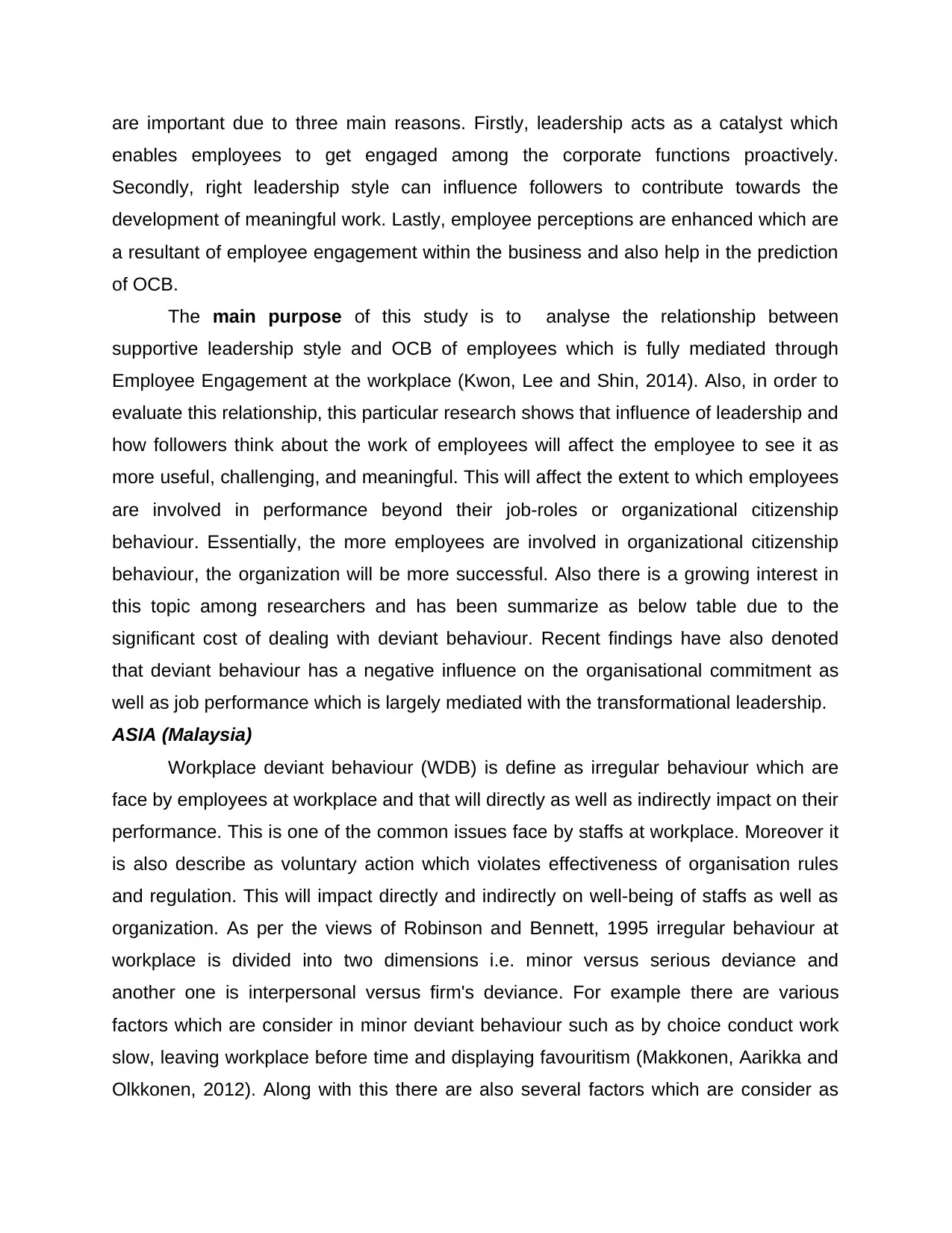
are important due to three main reasons. Firstly, leadership acts as a catalyst which
enables employees to get engaged among the corporate functions proactively.
Secondly, right leadership style can influence followers to contribute towards the
development of meaningful work. Lastly, employee perceptions are enhanced which are
a resultant of employee engagement within the business and also help in the prediction
of OCB.
The main purpose of this study is to analyse the relationship between
supportive leadership style and OCB of employees which is fully mediated through
Employee Engagement at the workplace (Kwon, Lee and Shin, 2014). Also, in order to
evaluate this relationship, this particular research shows that influence of leadership and
how followers think about the work of employees will affect the employee to see it as
more useful, challenging, and meaningful. This will affect the extent to which employees
are involved in performance beyond their job-roles or organizational citizenship
behaviour. Essentially, the more employees are involved in organizational citizenship
behaviour, the organization will be more successful. Also there is a growing interest in
this topic among researchers and has been summarize as below table due to the
significant cost of dealing with deviant behaviour. Recent findings have also denoted
that deviant behaviour has a negative influence on the organisational commitment as
well as job performance which is largely mediated with the transformational leadership.
ASIA (Malaysia)
Workplace deviant behaviour (WDB) is define as irregular behaviour which are
face by employees at workplace and that will directly as well as indirectly impact on their
performance. This is one of the common issues face by staffs at workplace. Moreover it
is also describe as voluntary action which violates effectiveness of organisation rules
and regulation. This will impact directly and indirectly on well-being of staffs as well as
organization. As per the views of Robinson and Bennett, 1995 irregular behaviour at
workplace is divided into two dimensions i.e. minor versus serious deviance and
another one is interpersonal versus firm's deviance. For example there are various
factors which are consider in minor deviant behaviour such as by choice conduct work
slow, leaving workplace before time and displaying favouritism (Makkonen, Aarikka and
Olkkonen, 2012). Along with this there are also several factors which are consider as
enables employees to get engaged among the corporate functions proactively.
Secondly, right leadership style can influence followers to contribute towards the
development of meaningful work. Lastly, employee perceptions are enhanced which are
a resultant of employee engagement within the business and also help in the prediction
of OCB.
The main purpose of this study is to analyse the relationship between
supportive leadership style and OCB of employees which is fully mediated through
Employee Engagement at the workplace (Kwon, Lee and Shin, 2014). Also, in order to
evaluate this relationship, this particular research shows that influence of leadership and
how followers think about the work of employees will affect the employee to see it as
more useful, challenging, and meaningful. This will affect the extent to which employees
are involved in performance beyond their job-roles or organizational citizenship
behaviour. Essentially, the more employees are involved in organizational citizenship
behaviour, the organization will be more successful. Also there is a growing interest in
this topic among researchers and has been summarize as below table due to the
significant cost of dealing with deviant behaviour. Recent findings have also denoted
that deviant behaviour has a negative influence on the organisational commitment as
well as job performance which is largely mediated with the transformational leadership.
ASIA (Malaysia)
Workplace deviant behaviour (WDB) is define as irregular behaviour which are
face by employees at workplace and that will directly as well as indirectly impact on their
performance. This is one of the common issues face by staffs at workplace. Moreover it
is also describe as voluntary action which violates effectiveness of organisation rules
and regulation. This will impact directly and indirectly on well-being of staffs as well as
organization. As per the views of Robinson and Bennett, 1995 irregular behaviour at
workplace is divided into two dimensions i.e. minor versus serious deviance and
another one is interpersonal versus firm's deviance. For example there are various
factors which are consider in minor deviant behaviour such as by choice conduct work
slow, leaving workplace before time and displaying favouritism (Makkonen, Aarikka and
Olkkonen, 2012). Along with this there are also several factors which are consider as
Paraphrase This Document
Need a fresh take? Get an instant paraphrase of this document with our AI Paraphraser
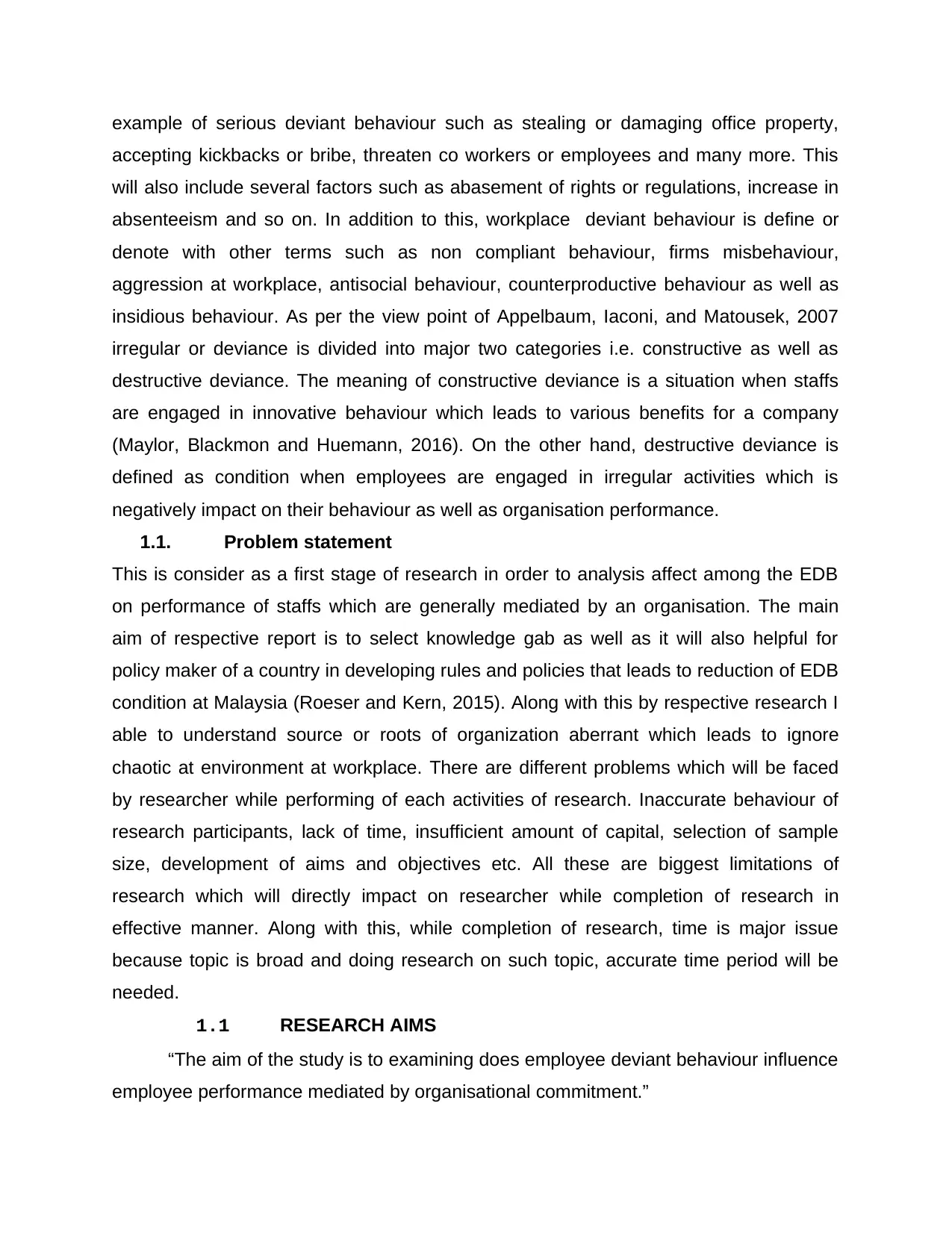
example of serious deviant behaviour such as stealing or damaging office property,
accepting kickbacks or bribe, threaten co workers or employees and many more. This
will also include several factors such as abasement of rights or regulations, increase in
absenteeism and so on. In addition to this, workplace deviant behaviour is define or
denote with other terms such as non compliant behaviour, firms misbehaviour,
aggression at workplace, antisocial behaviour, counterproductive behaviour as well as
insidious behaviour. As per the view point of Appelbaum, Iaconi, and Matousek, 2007
irregular or deviance is divided into major two categories i.e. constructive as well as
destructive deviance. The meaning of constructive deviance is a situation when staffs
are engaged in innovative behaviour which leads to various benefits for a company
(Maylor, Blackmon and Huemann, 2016). On the other hand, destructive deviance is
defined as condition when employees are engaged in irregular activities which is
negatively impact on their behaviour as well as organisation performance.
1.1. Problem statement
This is consider as a first stage of research in order to analysis affect among the EDB
on performance of staffs which are generally mediated by an organisation. The main
aim of respective report is to select knowledge gab as well as it will also helpful for
policy maker of a country in developing rules and policies that leads to reduction of EDB
condition at Malaysia (Roeser and Kern, 2015). Along with this by respective research I
able to understand source or roots of organization aberrant which leads to ignore
chaotic at environment at workplace. There are different problems which will be faced
by researcher while performing of each activities of research. Inaccurate behaviour of
research participants, lack of time, insufficient amount of capital, selection of sample
size, development of aims and objectives etc. All these are biggest limitations of
research which will directly impact on researcher while completion of research in
effective manner. Along with this, while completion of research, time is major issue
because topic is broad and doing research on such topic, accurate time period will be
needed.
1.1 RESEARCH AIMS
“The aim of the study is to examining does employee deviant behaviour influence
employee performance mediated by organisational commitment.”
accepting kickbacks or bribe, threaten co workers or employees and many more. This
will also include several factors such as abasement of rights or regulations, increase in
absenteeism and so on. In addition to this, workplace deviant behaviour is define or
denote with other terms such as non compliant behaviour, firms misbehaviour,
aggression at workplace, antisocial behaviour, counterproductive behaviour as well as
insidious behaviour. As per the view point of Appelbaum, Iaconi, and Matousek, 2007
irregular or deviance is divided into major two categories i.e. constructive as well as
destructive deviance. The meaning of constructive deviance is a situation when staffs
are engaged in innovative behaviour which leads to various benefits for a company
(Maylor, Blackmon and Huemann, 2016). On the other hand, destructive deviance is
defined as condition when employees are engaged in irregular activities which is
negatively impact on their behaviour as well as organisation performance.
1.1. Problem statement
This is consider as a first stage of research in order to analysis affect among the EDB
on performance of staffs which are generally mediated by an organisation. The main
aim of respective report is to select knowledge gab as well as it will also helpful for
policy maker of a country in developing rules and policies that leads to reduction of EDB
condition at Malaysia (Roeser and Kern, 2015). Along with this by respective research I
able to understand source or roots of organization aberrant which leads to ignore
chaotic at environment at workplace. There are different problems which will be faced
by researcher while performing of each activities of research. Inaccurate behaviour of
research participants, lack of time, insufficient amount of capital, selection of sample
size, development of aims and objectives etc. All these are biggest limitations of
research which will directly impact on researcher while completion of research in
effective manner. Along with this, while completion of research, time is major issue
because topic is broad and doing research on such topic, accurate time period will be
needed.
1.1 RESEARCH AIMS
“The aim of the study is to examining does employee deviant behaviour influence
employee performance mediated by organisational commitment.”
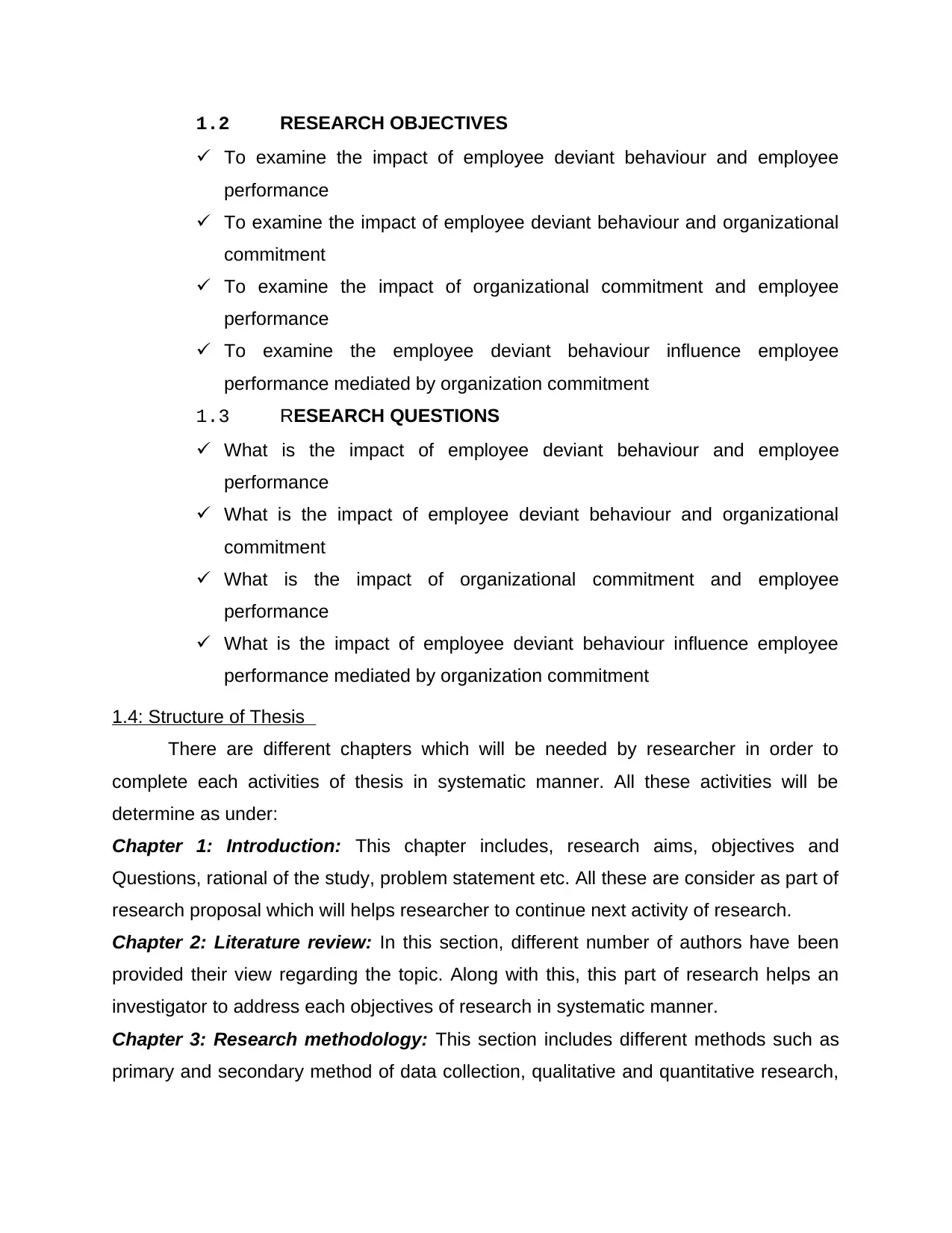
1.2 RESEARCH OBJECTIVES
To examine the impact of employee deviant behaviour and employee
performance
To examine the impact of employee deviant behaviour and organizational
commitment
To examine the impact of organizational commitment and employee
performance
To examine the employee deviant behaviour influence employee
performance mediated by organization commitment
1.3 RESEARCH QUESTIONS
What is the impact of employee deviant behaviour and employee
performance
What is the impact of employee deviant behaviour and organizational
commitment
What is the impact of organizational commitment and employee
performance
What is the impact of employee deviant behaviour influence employee
performance mediated by organization commitment
1.4: Structure of Thesis
There are different chapters which will be needed by researcher in order to
complete each activities of thesis in systematic manner. All these activities will be
determine as under:
Chapter 1: Introduction: This chapter includes, research aims, objectives and
Questions, rational of the study, problem statement etc. All these are consider as part of
research proposal which will helps researcher to continue next activity of research.
Chapter 2: Literature review: In this section, different number of authors have been
provided their view regarding the topic. Along with this, this part of research helps an
investigator to address each objectives of research in systematic manner.
Chapter 3: Research methodology: This section includes different methods such as
primary and secondary method of data collection, qualitative and quantitative research,
To examine the impact of employee deviant behaviour and employee
performance
To examine the impact of employee deviant behaviour and organizational
commitment
To examine the impact of organizational commitment and employee
performance
To examine the employee deviant behaviour influence employee
performance mediated by organization commitment
1.3 RESEARCH QUESTIONS
What is the impact of employee deviant behaviour and employee
performance
What is the impact of employee deviant behaviour and organizational
commitment
What is the impact of organizational commitment and employee
performance
What is the impact of employee deviant behaviour influence employee
performance mediated by organization commitment
1.4: Structure of Thesis
There are different chapters which will be needed by researcher in order to
complete each activities of thesis in systematic manner. All these activities will be
determine as under:
Chapter 1: Introduction: This chapter includes, research aims, objectives and
Questions, rational of the study, problem statement etc. All these are consider as part of
research proposal which will helps researcher to continue next activity of research.
Chapter 2: Literature review: In this section, different number of authors have been
provided their view regarding the topic. Along with this, this part of research helps an
investigator to address each objectives of research in systematic manner.
Chapter 3: Research methodology: This section includes different methods such as
primary and secondary method of data collection, qualitative and quantitative research,
⊘ This is a preview!⊘
Do you want full access?
Subscribe today to unlock all pages.

Trusted by 1+ million students worldwide
1 out of 84
Related Documents
Your All-in-One AI-Powered Toolkit for Academic Success.
+13062052269
info@desklib.com
Available 24*7 on WhatsApp / Email
![[object Object]](/_next/static/media/star-bottom.7253800d.svg)
Unlock your academic potential
Copyright © 2020–2025 A2Z Services. All Rights Reserved. Developed and managed by ZUCOL.





